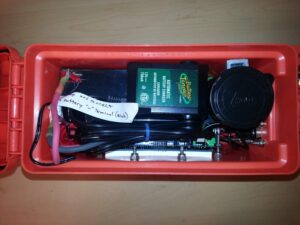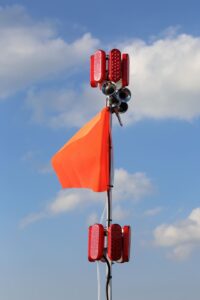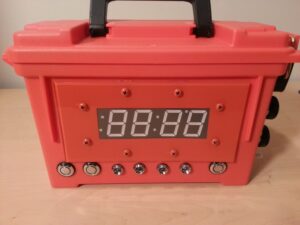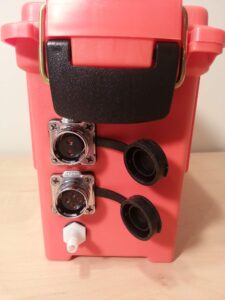The purpose of the R/C Start Timer is to simplify the duties of the Race Committee. It accomplishes this by automating horns, displaying current sequence time, and by replacing the time-sensitive flag signals with automated lights.
This timer has been born from a proposal we made to the US Sailing organization for a lighted start sequence. That proposal can be seen in other posts on this page, as well as in the Sequences appendix of this user’s manual.
The latest version of the Start Timer is complete as of 2020. It has been used for two seasons with our club, the local sailing school, and at a club on Lake St. Clair.
The Hardware:
The unit comes with its own battery, air compressor, buzzer, and digital display inside of a water-resistant box.
- Left Button: Power On
- Second Button: Run Sequence
- Right Button: Manual Horn (sounds as long as the button is held)
- Display: Count down (or count up) during the sequence. Also shows the configuration menu.
- 4-LED’s below screen: Ultra-bright, used to signal approaching flag changes (30 sec, 20, 10, 5,4,3,2,1,0)
- Built-in Buzzer: Audible alerts to the crew of the R/C boat of upcoming flag changes – buzzes in tune with the LED’s. Useful so your crew can watch the line instead of the timer screen!
The horns are made by Wolo and are easily audible in all directions for 2+ miles. It’s a good idea to mount them away from R/C personnel. They can be muffled if necessary.
The battery is a 12v 9Ah AGM and depending on use, rarely needs charging. Charger is built in. The timer has a low battery indicator which starts blinking when you’re down to around 5-10 sequences of battery life left. I typically charge it once mid-season (after 2-3 months of use, or around 50 sequences using both horns and lights).
The display uses large 1.2″ digits and can be seen from a distance. It can wash out in bright light, so position the display to not face the sun. The 4-LED’s below the screen can be seen in all lighting conditions – they and the buzzer make the screen redundant within 30 seconds of signals. After all – you should be watching the line, and not the timer!
Everything is water resistant. It can take heavy downpours! The only caveat is that it contains an air compressor – there are tiny air holes on the back side. Do not lay it face up in standing water or some water may be sucked in when the horns operate. Even if that happens, it should continue to run just fine. Simply remember to dry it out when you get back to shore. Note that this unit has been tested in fresh water only – your experience may vary in saltwater conditions.

This unit runs on an ATMega1284p processor (big brother to Arduino devices) on a custom printed circuit board.
Sequences:
The following sequences are supported, but the software can easily be updated to support ANY sequence you can think of:
- RRS 26
- RRS 26 (4-minute)
- RRS Appx U (Sound Signal)
- RRS Appx C (Match Racing)
- ICSA Appx C
- Numerous Rolling configurations and repetition settings.
- Numerous light visibility configurations.
Choosing which sequence to run is done in the menus (see the users guide for details).
Adding new sequences is done in the firmware. Such updates are emailed or posted online in the form of a small Hex file. Copy that file onto a MicroSD card (card is included, usb card reader is not), power the unit on, and your sequence or other software updates will be installed automatically.
The Lights:
(optional, but highly recommended)
This innovative concept replaces the two start sequence flags (Preparatory and Class Flag) with two sets of lights mounted vertically. Sailors simply look for the lights instead of flags: one light = one flag. Two lights = two flags. See the diagram and Sequences document for more details.
Currently, the lights are made up of super-bright leds from semi-trailer break lights. They are visible in bright sunlight from any direction at up to a mile or more. In overcast or dusk conditions, they can be seen for many miles (I may add a dimming feature for night use, if requested). They are visible in ALL conditions and have seen several years of use in hundreds of events – our sailors have found them to be easy to see, highly accurate, and the transition away from flags was easy for everyone to understand (from novice sailors to highly experienced sailors).
The benefit of lights are that they remove the “human factor” from the start sequence. Volunteer race committees often have variability in how they raise flags. +/- one second or more, is quite common. When do sailors start timing – when the flag starts to go up, or when it’s fully up? Some clubs use poles, some use pulleys, some clubs do things…other ways… In my 30+ years of running sailboat races, I have seen quite a variety of ways to raise flags, and as much variety in the reliability of timing from those signals. Why go through the hassle of recruiting/paying someone simply to raise flags when that position can be automated? Spare your crew for more important things, such as watching the line for over-earlies!
More Details
The device is very well built, and the circuits and software are highly refined, but assembly of components is very much a home-built product.
I was planning on making these, but time and supply-chain issues have put that on hold. I may be able to help others build their own if they have some electronics or software experience. Eventually, I may make this an open-source project.
More information can be found in the Users Manual and Sequence documents.
RCST Users Manual
RCST AppxA(Sequences)
Reach out us on the contact form below if you have any questions!






